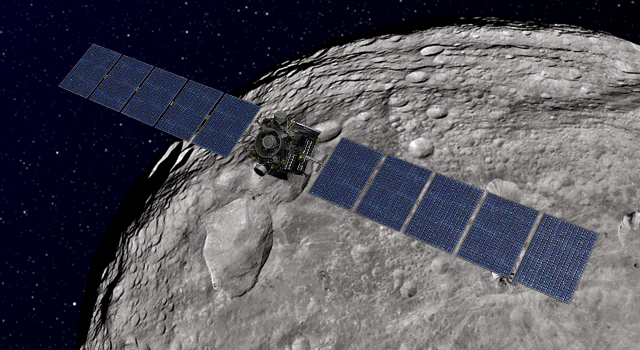News | June 14, 2012
Dawn Easing into its Final Science Orbit

› Full image and caption
After successfully completing nearly five months scrutinizing the giant asteroid Vesta at its lowest orbit altitude, NASA's Dawn spacecraft will begin its final major science data-gathering phase at Vesta on June 15, at an average altitude of 420 miles (680 kilometers) above the surface.
Over the past six weeks, Dawn has been gently spiraling up from its lowest orbit - 130 miles, or 210 kilometers, above the surface - to the final planned science orbit, known as high-altitude mapping orbit 2. Observations obtained from this orbit will provide a companion set of data and images to those obtained during the first high-altitude mapping orbit phase, completed in October 2011. A key difference will be that the angle of sunlight hitting Vesta has changed, illuminating more of its northern region. The principal science observations planned in this new orbit will be obtained with the framing camera and the visible and infrared mapping spectrometer.
Following this final science data gathering phase, Dawn will then spend almost five weeks spiraling out from the giant asteroid to the point at which Vesta will lose its gravitational hold on the spacecraft. That departure day is expected to be around Aug. 26. Dawn will turn to view Vesta as it leaves and acquire more data. Then, Dawn will set its sights on the dwarf planet Ceres, and begin a two-and-a-half year journey to investigate the largest body in the main asteroid belt. Dawn will enter orbit around Ceres in 2015.
Dawn's mission is managed by JPL for NASA's Science Mission Directorate in Washington. Dawn is a project of the directorate's Discovery Program, managed by NASA's Marshall Space Flight Center in Huntsville, Ala. UCLA is responsible for overall Dawn mission science. Orbital Sciences Corp. in Dulles, Va., designed and built the spacecraft. The German Aerospace Center, the Max Planck Institute for Solar System Research, the Italian Space Agency and the Italian National Astrophysical Institute are international partners on the mission team. The California Institute of Technology in Pasadena manages JPL for NASA.
To view the new images and for more information about Dawn, visit: http://www.nasa.gov/dawn and http://dawn.jpl.nasa.gov .
Over the past six weeks, Dawn has been gently spiraling up from its lowest orbit - 130 miles, or 210 kilometers, above the surface - to the final planned science orbit, known as high-altitude mapping orbit 2. Observations obtained from this orbit will provide a companion set of data and images to those obtained during the first high-altitude mapping orbit phase, completed in October 2011. A key difference will be that the angle of sunlight hitting Vesta has changed, illuminating more of its northern region. The principal science observations planned in this new orbit will be obtained with the framing camera and the visible and infrared mapping spectrometer.
Following this final science data gathering phase, Dawn will then spend almost five weeks spiraling out from the giant asteroid to the point at which Vesta will lose its gravitational hold on the spacecraft. That departure day is expected to be around Aug. 26. Dawn will turn to view Vesta as it leaves and acquire more data. Then, Dawn will set its sights on the dwarf planet Ceres, and begin a two-and-a-half year journey to investigate the largest body in the main asteroid belt. Dawn will enter orbit around Ceres in 2015.
Dawn's mission is managed by JPL for NASA's Science Mission Directorate in Washington. Dawn is a project of the directorate's Discovery Program, managed by NASA's Marshall Space Flight Center in Huntsville, Ala. UCLA is responsible for overall Dawn mission science. Orbital Sciences Corp. in Dulles, Va., designed and built the spacecraft. The German Aerospace Center, the Max Planck Institute for Solar System Research, the Italian Space Agency and the Italian National Astrophysical Institute are international partners on the mission team. The California Institute of Technology in Pasadena manages JPL for NASA.
To view the new images and for more information about Dawn, visit: http://www.nasa.gov/dawn and http://dawn.jpl.nasa.gov .


